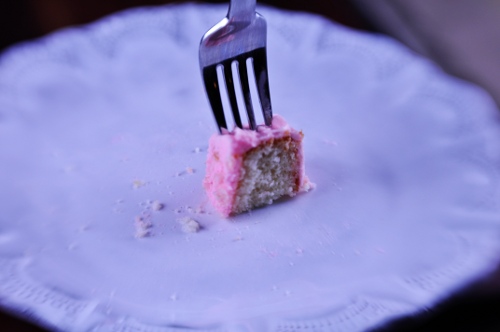DAY ONE
I feel pretty good!
Nice way to start off my experiment. Started getting peckish again
immediately after lunch, but I ate a peach about a half hour ago and that seems
to have done the trick, at least for now. I can feel myself getting
hungry fairly quickly though... talking about that peach made my stomach rumble
a little. Mmm. Yup. Just in the process of typing this, I'm a
solid 5.
Wow, I definitely
expected to feel hungry by now, but I'm still perfectly fine. I can sense
the hunger creeping on, though, and it's
making me nervous. I wish I could snack on something, just to be on the
safe side. There are pickles in the walk-in that I could eat… Will not, though, as an experiment, since the
idea is to not eat anything when I'm feeling perfectly comfortable.
I am HUNGRY. When
did that happen???
I'm still not home yet,
and I'm so hungry. I'm having trouble biking, I'm so hungry. The
wind feels like it's going to blow me over, I actually feel weak.
Now I'm worried. I'm ready to EAT THE WORLD right now.
This is the point where I become a bottomless pit.
If I had eaten those
cucumbers even though I wasn't hungry, maybe I wouldn't be going batshit insane
right now.
Okay, game plan:
Go home, have a quick salad and a handful of almonds IMMEDIATELY in an
attempt to sate me till I finish making dinner and stave off bad choices.
Game plan did NOT work.
Immediately shoved a handful of almonds into my mouth and then got to
work making the salad. Accidentally ate, like, a pound of cheese. I
don't even know how that happened. Opened the fridge to get the stuff dinner
all the sudden the cheese was in my mouth. And I didn't even care.
Ate a big spinach salad
and a decent-sized slice of pizza (homemade), which I decided was an
appropriate-sized meal. But despite having eaten cheese, almonds, salad
and a big slice of pizza, was still hungry, holding steady at a 3, 3.5. I
tried to hold out for a full 20 minutes, as I've been told that's how long it
takes for the stomach to process fullness... but I was just. too. damn. hungry.
UUUUUUUGGGGGHHHH. Ate another (smaller) piece of pizza.
It's been over 20
minutes now, and I'm still hungry. Could definitely eat some more, but can
refrain. I guess that puts me at a 5?
No - no, I'm not comfortable, I'm still HUNGRY. I'm a 4!
Wait, no, AM I a 4? W
But when I think about
how much I ate, I feel a little queasy, like I ate too much.... maybe I'm a 6,
working up to a 7? No, that CAN'T be right. I can’t be a 4 and a 6 at the same time.
I don't know!
How is it that I can’t
TELL how hungry I am!?!?
Right at the number
that I wasn't supposed to be at. I'm not SUPER-full - not terribly
uncomfortable, but definitely full. And starting to think about how much
cheese I ate. Oh god, why did I eat that much cheese? What is wrong
with me??
I'm hungry again.
“Slightly uncomfortable and starting to think about food again,” that's
me. Well, whatever tummy. It almost time for bed. That's all
you get.
DAY 2
Heading to yoga on my
bike, and I don't want to bite anybody's head off yet, but am about as
hungry as I can be before reaching that point. Not going to eat a
thing, though, as during hot yoga you can feel every little thing in your
stomach.
In hot yoga. Want
to throw up, and never look at food again.
If I had a fork, I
would take out my breakfast and start eating them right now. But I don't,
so I have to wait.
AND it's finally
breakfast time, so all is well!
So much for
breakfast. Still hungry, still thinking
about food. It’s only going to get worse from here and it's not even 10:00am . And I have nothing to snack on. It's going
to be a long, hard trek through the morning. I'll probably have to open a
bottle of Perrier in an hour or so and hope the bubbles trick my stomach into
thinking it's full long enough to get to lunch.
Went for
the Perrier and the bubbles trick is totally working.
The bubbles never help
for long. Grabbed a handful of carrots
meant for lunch about 45 minutes ago, but it didn’t help. Lunch is a 1pm .
Think I can last without going crazy with hunger.
REALLY hungry, thank
God it’s lunch.
I could definitely eat
more, but I've packed nothing more to eat and I'm okay with that. I'm
already getting hungry again, though, unbelievably.
Which
is not the worst at all.
OMG
OMG. Was planning on getting a muffin
and fruit salad at the coffee shop for dinner, but I need that muffin NOW. Okay, muffin now, maybe a sandwich for
dinner. That seems like an extravagant
snack, but at this point, I don’t effing care.
I
seriously inhaled that muffin. But I
feel sooooooo much better. And it’s
practically dinner time – maybe I shouldn’t get a sandwich after all?
Okay,
sure! Still feeling good, so I left the
coffee shop for rehearsal this evening sandwichless. I feel comfortable, but nervous about my
choice.
Everyone
around me is cracking open sack-dinners.
They look so good. Rehearsal is
until 10pm . This is going to
suck.
God I’m
dumb.
Dammit. When I get home I’m going to eat too late and
too much.















